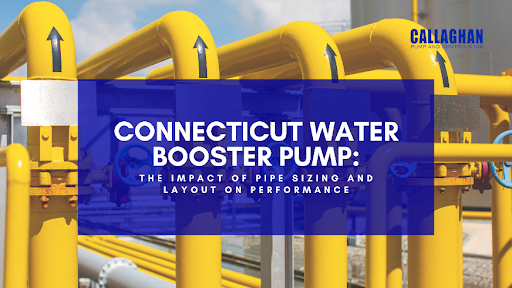Connecticut Water Booster Pump: The Impact of Pipe Sizing and Layout on Performance
April 28th, 2025
If you plan to install a Connecticut water booster pump, you would probably be concerned about the pump itself—model numbers, horsepower, pressure rating, and flow capacity. That’s important, no question. However, what is often overlooked is the impact pipe sizing and system layout have on performance. Even the most efficient pump will not work well if the piping system is improperly installed.
This blog will examine how pipe size, layout design, and flow conditions directly affect how a Connecticut water booster pump works. Getting these basics right improves the pump’s performance and the entire system’s ability to produce consistent water pressure.
Why Pipe Sizing Affects Performance?
Pipe size directly impacts how efficiently water moves through the system. The booster pump won’t perform as expected if the pipe is too small or too large for the intended flow. This factor is tied to pressure loss, flow restrictions, and long-term wear.
- Flow Restriction: Smaller diameter pipes limit how much water can move through the system. This causes a drop in the flow rate and forces the pump to operate under higher pressure. Over time, this reduces both pump performance and energy efficiency.
- Friction Loss: As water flows through pipes, it rubs against the inside surface. Friction per foot is much greater in smaller pipes. The higher the friction loss, the harder the Connecticut water booster pump will have to work to maintain the desired pressure.
- Pump Strain and Wear: Incorrect sizing of pipes adds to the total dynamic head (TDH) of the system. This will impact the pump’s duty point and can move it outside of its recommended curve. In this case, operating off-curve can result in much higher temperatures and a considerably reduced service life.
How Layout Affects Your Pump’s Performance?
Layout has a direct effect on how a Connecticut water booster pump performs. How pipes are arranged controls pressure, flow, and the load on the pump. A poor layout wastes energy and can lead to an uneven water supply across different floors.
- Excessive Fittings and Bends: Each 90-degree elbow adds several feet of straight pipe in pressure loss. Multiple fittings can quickly raise the system’s resistance. This leads to lower outlet pressure even if the pump is correctly sized.
- Unsupported Pipe Runs: Pipes need appropriate anchoring and periodic support. Over time, unsupported horizontal runs sag, causing air to be trapped and flow unevenly. These factors can affect the performance of Connecticut water booster pumps.
- Elevation Changes: For every 2.31 feet of elevation, pressure drops by one psi. Improper layout that climbs too steeply reduces pressure on upper floors. Without pressure zone planning, booster pumps can’t compensate for gravity independently.
What to Consider During the Pump Setup?
Choosing the right Connecticut water booster pump is only part of the process. Another thing is knowing how the system setup can affect your pump’s performance, reliability, and longevity. Careful attention to placement, flow demands, and supporting components makes all the difference.
- System Demand and Flow Rate: Calculate total demand using fixture units and convert it to gallons per minute (GPM). Pumps are selected based on peak flow needs, not average use. Accurate sizing prevents both oversupply and pressure loss.
- Pump Placement: Connecticut water booster pumps should be the shortest distance from the main supply point. The reduced head loss from suction improves the net positive suction head available. So, avoid placing pumps after tight bends or reducers.
- Valve and Accessories: Add a check valve to avoid backflow and protect the pump. Add pressure relief valves to safeguard the system against surges. Additionally, air relief valves should be installed to keep trapped air from producing cavitation.
Three Signs Your Layout Needs an Upgrade
Even if you choose the right pump, the system’s layout will prevent it from working efficiently. Most pump-related complaints are caused by poor pipe design. Here are some signs that you may need to modify your layout:
- Inconsistent Pressure: The top floors have weak pressure, while lower levels see strong flow. This points to poor layout planning or insufficient booster capacity. Balancing zones and correcting pipe sizing may fix it.
- Repeated Cycling of the Pumps: Pump destruction occurs from repeated cycling of the pump motor and controller. Short cycling can be a symptom of an oversized pressure tank; depending on the arrangement, it can create a water hammer. Fixing it can enhance your pump’s life.
Unusual System Noise: Pipe knocking or a high, whining noise indicates turbulence or air traps. These can be caused by poorly designed fittings, layouts, or improper slopes. A plumbing audit can quickly identify the problem.
Connecticut water booster pumps can only supply consistent pressure if the pipeline supports them. Furthermore, proper layout and pipe sizing increase pump life, reduce energy loss and ensure user comfort. Need help selecting the right booster pump for the design of your system? Speak with our specialists now for professional advice on pump sizing, layout, and product fit to ensure your system works from the start.













